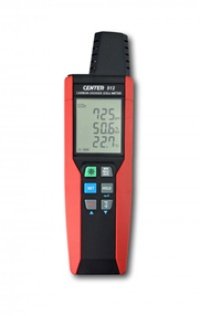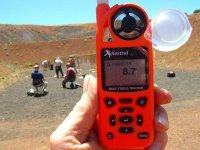How to Setup the Davis Instruments AirLink Air Quality Sensor (IC-7210)

The new Davis Instruments AirLink Air Quality Meter is a professional sensor for indoor or outdoor use. It measures particulate matter, several key weather parameters and sends all information straight to your mobile or computer via WIFI at 60-second intervals.
Want to know more about this innovative product? Learn how to set up the Davis Instruments AirLink Air Quality Meter here!
Figure 1 Watch an Instrument Choice scientist demonstrate how to set up the Davis Instruments AirLink Air Quality Meter (IC-7210) here.
Installation Requirements and Materials
Included with Air Quality Meter
- AirLink Air Quality Meter
- Outdoor cover
- Power cable
- Mounting bracket; and
- The footpads for desk mounting or the mounting screws if installing on a vertical surface.
Not Included
- Wi-Fi internet connection
- Wi-Fi password
- Phone with Bluetooth enabled
- AC power; and
- Drill or screwdriver (if mounting on a vertical surface).
How to Setup the Davis Instruments AirLink Air Quality Meter (IC-7210)
- Download the Weatherlink app. Links to download this app are in the additional links (below).
- Log in using your username and password. If you do not have an account yet, press “sign up” and follow the prompts.
- To get started, press the “Account” icon in the top right corner.
- Under “Devices” click “Add.”
- Select “AirLink”.
- Choose between installing on an existing device (this is if you have a pre-existing Davis station, Enviromonitor etc.) or select setup your IC-7210 as a standalone monitor. For this example, we will set up the AirLink as a standalone sensor.
- Plug the AirLink in using the included power cable. The blue LED on the sensor will illuminate.
- Press “Next” on the phone.
- The next step is to connect to Bluetooth. Confirm your phone has Bluetooth enabled then press “Connect”.
- Click on your planned setup environment, choose between inside and outside.
- Press “Next”.
- Enter a name for your AirLink and press “Next”.
- Select a location. You can select by moving around on the map or by manually entering your address. Click “Next” when your location is correct.
- Read and accept the terms and conditions, then wait a moment as the unit configures.
- Once configured, the app will request set up of WIFI connection. Select “Use WIFI”.
- Press “Next”.
- The available WIFI networks will appear on the screen. Select your WIFI network, then enter your password.
- Press “Next”.
- At this stage, you can choose to upgrade to WeatherLink PRO. Otherwise, click “Use basic”.
- AirLink set up is complete. From here, you can select “Add more” to set up additional sensors or “Complete.”
- Pressing complete takes you to the WeatherLink main page, where your newly setup device will be visible. It might take some time for your information to first load into WeatherLink. We recommend leaving your unit for around 10-15 minutes.
- After 10-15 minutes have elapsed you will be able to see all available data including;
- To-the-minute particulate matter measurements – check out your PM1, PM5 and PM10.
- Current weather parameters including the temperature, humidity, dewpoint, heat index and wet-bulb readings.
- The Air Quality Trend: See a 24-hour air quality trend to know how your air quality is changing.
- NowCast Air Quality Index: Is an easy-to-understand, colour-coded description of current air quality conditions. NowCast is the EPA’s standard for representing fast-changing air quality.
- Alarms: Set your alarm’s thresholds so you can be notified via text or email when conditions are suboptimal.
- Forecasts: You can select to view either a 7-day or hourly forecast
Mounting your Davis Instruments AirLink Air Quality Sensor
Your Davis Instruments AirLink can be mounted indoors or outdoors providing AC power, and adequate airflow is available.
Mounting on a flat surface (indoor only)
- Stick the included foot pads to the feet of the sensor.
- Slide down and remove the mounting bracket.
- Place the sensor on the flat surface, with the Davis logo facing upward. The function of the raised food pads under the sensor is to ensure adequate airflow through the sensor.
Mounting on a vertical surface
- Choose a location that is shady, protected and has good airflow. Avoid placing near any kitchen exhaust fans, air conditioning vents or water heaters.
- Slide off and remove the mounting bracket from the sensor housing.
- Use the bracket as a template to mark screw holes, then use a drill to create pilot holes in the mounting surface.
- Use the included screws to mount the bracket to the wall.
- Slide the sensor housing down onto the bracket. It will click into place. Then;
- If installing inside: installation is complete.
- If installing outside: slide the sensor cover over the sensor housing.
Conclusion
The all-new AirLink Air Quality Meter is an accurate and versatile sensor backed by Davis Instruments reputation for durability and quality.
For more information on the Davis Instruments AirLink Air Quality Sensor, see the links below or contact us!
Additional links
- View the comprehensive list of features and specifications for the Davis Instruments AirLink Air Quality Meter here
- Download Weatherlink from Davis Instruments for Apple Devices
- Download Weatherlink from Davis Instruments for Android Devices
- Create a login or view Weatherlink in a web browser here.
- Want a scientists’ review? Read the Instrument Choice blog article "Your First Step to Clean Air: Introducing the NEW Davis AirLink Air Quality Meter" (TL;DR we think it’s excellent!)
- Want to see what comes in the box? Watch an Instrument Choice Scientist "Unboxing the Davis AirLink Air Quality Meter (IC-7210)"
Also interesting
The IC-CENTER512 is an accurate carbon dioxide meter with a reliable dual wavelength NDIR (non-dispersive infrared) sensor. This CO2 meter offers data logging up to 32000 points, adjustable alarms, data hold, plus maximum, minimum, short term exposure and time-weighted average functions all on an easy-to-navigate unit.
The IC-CENTER512 CO2 meter makes carbon dioxide concentration logging easy. Get your step-by-step setup guide for the IC-CENTER512 carbon dioxide (CO2) meter here!

A multifunction environment meter is a scientific instrument that allows a user to measure a host of parameters without the need to swap meters or have multiple units. These devices are popular with professionals or students who spend a lot of time working in the field. In roles such as engineers, field technicians and researchers.


